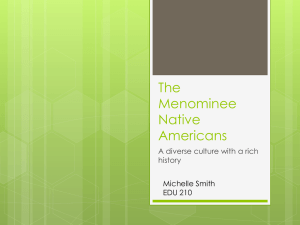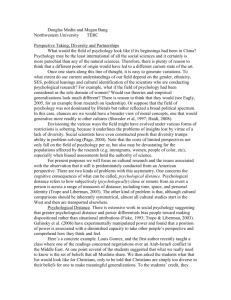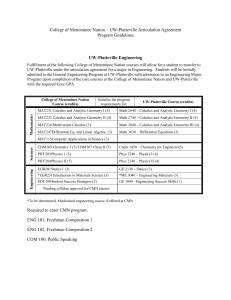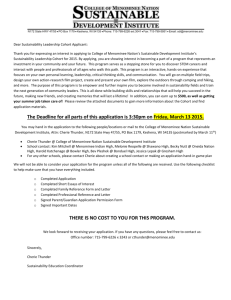Culture, Mental Models, Values and Environmental Decision Making
advertisement
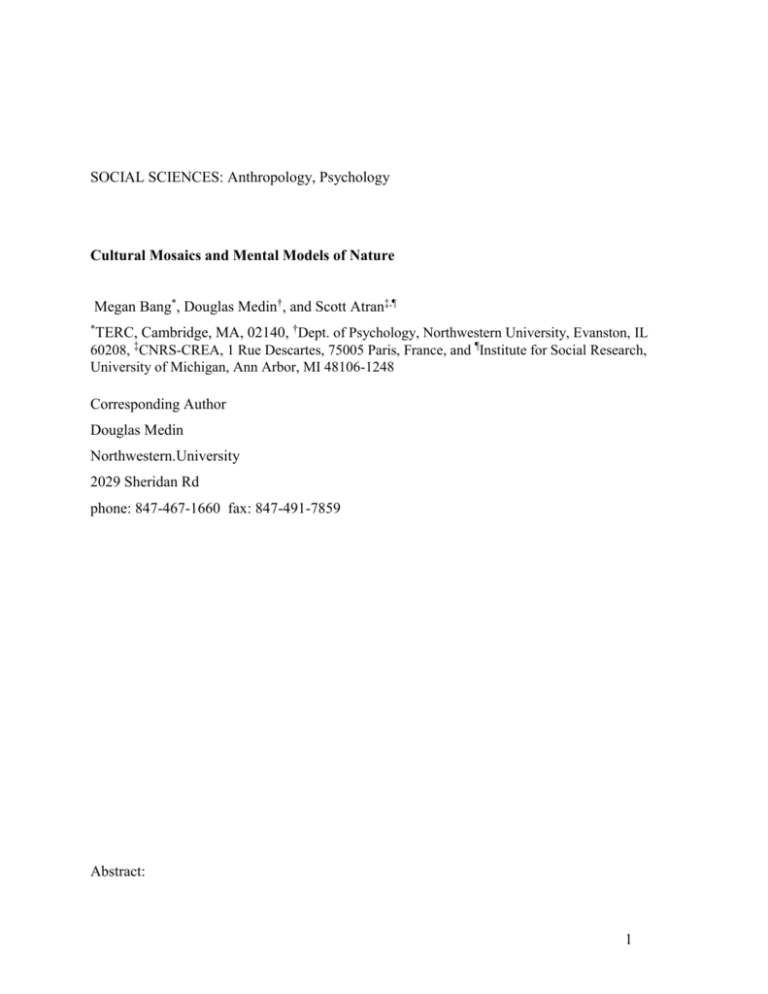
SOCIAL SCIENCES: Anthropology, Psychology Cultural Mosaics and Mental Models of Nature Megan Bang*, Douglas Medin†, and Scott Atran‡,¶ TERC, Cambridge, MA, 02140, †Dept. of Psychology, Northwestern University, Evanston, IL 60208, ‡CNRS-CREA, 1 Rue Descartes, 75005 Paris, France, and ¶Institute for Social Research, University of Michigan, Ann Arbor, MI 48106-1248 * Corresponding Author Douglas Medin Northwestern.University 2029 Sheridan Rd phone: 847-467-1660 fax: 847-491-7859 Abstract: 1 For much of their history the relationship between anthropology and psychology is well captured by Robert Frost’s poem, “Mending Wall” which ends with the ironic line, “good fences make good neighbors.” The congenial fence was that anthropology studied what people think and psychology studied how people think. Recent research, however, shows that content and process cannot be neatly segregated, because cultural differences in what people think affect how people think. To achieve a deeper understanding of the relation between process and content, research must integrate the methodological insights from both anthropology and psychology. We review previous research and describe new studies in the domain of folk biology which examine the cognitive consequences of different conceptualizations of nature and the place of humans within it. The focus is on cultural differences in framework theories (epistemological orientations) among Native-American (Menominee) and European-American children and adults living in close proximity in rural Wisconsin. Our results show that epistemological orientations affect memory organization, (ecological) reasoning, and the perceived role of humans in nature. This research also demonstrates that cultural differences in framework theories have implications for understanding inter-group conflict over natural resources and are relevant to efforts to improve science learning, especially among Native-American children.. This review examines cognitive and behavioral consequences of cultural differences in conceptions of nature and conceptions of the role of human beings in it. The evidence suggests 2 that these consequences are considerable and as we piece them together they form something of a mosaic. We concentrate on a set of comparative studies of a particular Native-American and European-American culture population, but the results are consistent with our previous findings and further suggest wider implications for culture and learning, in general, and science education, in particular. Our work falls at the interface between cognitive psychology and anthropology. A few decades ago these two fields enjoyed a congenial division of labor under which cognitive psychology’s mission was to determine how people think and anthropology’s focus was on what people think (1). But recent empirical research by cultural psychologists, cognitive anthropologists and even philosophers (2-6) provides convincing evidence that cultural processes affect cognitive processes. These new observations have led to corresponding theoretical analyses. One approach to understanding cultural differences in cognitive processing (7) appeals to a “cognitive toolkit” and argues that cultures are associated with differences in the use and accessibility of particular strategies drawn from a common set of tools. Another approach (8) suggests that culture affects the chronic accessibility of constructs for approaching the social world (e.g. individualism versus collectivism) and that these constructs also affect perceptual and cognitive processes associated with the nonsocial world. Our orientation also draws on the idea that abstract framework theories (or epistemological orientations) constrain cognition but assumes that cultural framework theories may be domain-specific (9). Framework Theories, Cultural Models and Meaning. Cultural framework theories provide individuals with skeletal principles for meaning making, including beliefs about what sorts of things are relevant, worthy of attention and in need of explanation. Religion may be a good case in point (10). Here, specific beliefs about the creation of the world, its ultimate cause and function provide a lens that people may use to derive meanings for particular contexts and behaviors. Religion may provide a causal framework for important events surrounding humans, such as illness, misfortune and death. Our work focuses on the domain of biology and the natural world. We will describe our research with the two cultural groups living in close proximity in north central Wisconsin, 3 rural Native-Americans from the Menominee Nation and rural European-Americans living in an adjacent county in northcentral Wisconsin.1 Menominee. The Menominee are the oldest continuous residents of Wisconsin. Historically, their lands covered much of Wisconsin but were reduced, treaty-by-treaty, until the present 95,000 hectares was reached in 1856. There are 4-5000 Menominee living on tribal lands in three small communities. Despite economic incentives to the contrary, the Menominee have preserved diversity and habitat types of their forest (13; 14), which is managed by a tribal corporation. They enjoy an international reputation for their sustainable forestry practices (15). European-American. Just south of the reservation is Shawano County (opulation about 40,000), the other focal area for our research. The major sources of income in the town of Shawano are light manufacturing, small-scale farming, and tourist recreation, mainly in the form of hunting, fishing, boating, jet-skiing and snowmobiling. Shawano Lake is a major attraction and there are also several rivers and smaller lakes in the county. Outdoor recreation is important to many of the county residents and many adults have fished since they were young children. Culture, Mental Models and Children’s Biology. For at least several decades there has been an enduring interest in the development of children’s understanding of biology. Perhaps the most influential work on this topic was pioneered by Carey (16), who argued forcefully that development within the domain of biological knowledge entails radical conceptual change in children’s core concepts and theories. This conclusion has been based largely on children’s and adults’ performance in a category-based induction task (16). In this task, children (ranging from 4-10 yrs of age) are introduced to a picture of a base-item (a human, dog or bee), and taught a new property about it. For example, the interviewer might show a picture of a dog, saying, “Have you ever heard of an omentum? Omenta are very thin, yellowish things. Here is a picture of 1 An important aspect of this work is the evolution of the methodological and theoretical frames our studies employ. Much of the work in cognitive science, and subsequent understandings of human cognition, has been based on studies largely comprised of white middle-upper class urban or suburban children and adults. The necessity to diversify the representation of participants in empirical work in cognitive science cannot be over-stated; however this raises at least two important issues that are not unrelated to this work. For many communities of color, especially American Indians, research often has been an exploitive and an unwelcome enterprise. Indigenous scholars and communities have been developing appropriate guidelines for conducting research with Indigenous communities and tribal IRB processes to ensure that previous research-based assaults on tribal communities are not continued – these efforts are fundamentally acts of sovereignty (11, 12). Second, research agendas need to meet needs of the communities that are involved in the work. This means that much of the research conducted becomes problem-driven. We believe that problem-driven research can provide rich contexts in which to do both applied and theoretical work. 4 something that has an omentum inside it.” Next, children are tested for their tendency to generalize (or to “project”) that property to other objects (including other humans, dogs, aardvarks, dodos, stinkoos, bees, worms, flowers, sun, clouds, harvesters and garlic presses). Carey found that for young (4-5 yr-old) children: (1) projections from humans as a base were stronger than projections from either dog or bee; (2) there were strong asymmetries in projections to and from humans (e.g., inferences from human to dog were stronger than from dog to human); and (3) in some cases violations of similarity occurred (e.g., inferences from human to bug were stronger than from bee to bug). This pattern has been interpreted as evidence that young children's conceptions of the natural world are anthropocentric. Research on children’s biology has been conducted almost exclusively with individuals from North American, urban, technologically-dependent populations. Thus, it is not clear which aspects of children’s naïve biology depend on cultural conceptions or conditions of learning or some combination of both. To evaluate the role of cultural milieu and conditions of learning in children’s inductive reasoning we initially studied three populations: urban (mostly EuropeanAmerican) Boston children, rural Wisconsin European-American culture children, and rural Menominee children of varying ages (17). The participants were given Human, Wolf, Bee, and Goldenrod as bases and several mammals, birds, reptiles, invertebrates, plants, natural inanimates and artifacts as targets. As in Carey’s studies, properties were unfamiliar internal substances of the form “has X inside.” The detailed procedures differed in a number of ways from those used by Carey so direct comparisons with her results must be qualified with caution. The most relevant data derive from the rural populations. Both cultural groups showed the mature pattern of generalizing in terms of biological affinity even at the youngest ages (4-6 yrs.). This suggests that the anthropocentric pattern of generalization noted by Carey may depend on a relative lack of intimate experience with animals and plants (18). Rural children generalized more from wolf to other mammals than from humans to other mammals, a pattern consistent with humans being seen as atypical animals. But there were also two striking differences among the two rural populations. Rural European-American children of all ages showed asymmetries in reasoning between humans and animals and often justified a failure to extend a property from an animal to humans on the grounds that “people are not animals.” In contrast, Menominee children of all ages showed no reliable human-animal asymmetries and were much less likely to say that people are not animals. 5 The Menominee creation story has people coming from the bear, and even the youngest children are familiar with the animal-based clan system. In short, there is an explicit cultural support for a symmetrical relation between humans and other animals. The second main result concerns a strategy for reasoning that we did not observe with urban children---reasoning in terms of ecological relations. For example, children might justify generalizing from bees to bears because a bee might sting a bear or a bear might acquire the property by eating the bee’s honey. Ecological reasoning was a common strategy among even the youngest Menominee children but was only common for the oldest rural majority culture children. This community difference was evident in both patterns of generalization (e.g. relatively greater generalization from bees to bear and to plants) and in justifications that children reported for their projections (18). In summary, both culture and experience affect children’s anthropocentrism and propensity for ecological reasoning. Mental Models of Nature Among Fish Experts. To further explore the extent to which these findings permeated these two communities, we studied models of fish and aquatic ecology with local fish experts in the two communities (19, 20). Standard sorting techniques and other probes were used to explore each group’s categorization of local fish species, and perceived ecological relationships (fish-fish interactions). To foreshadow our results, the data show that both groups of experts shared a knowledge base concerning local freshwater fish and their habitats, though that knowledge was organized differently across groups. The participants were (non-professional) experts in freshwater fish and fishing. We used peer nominations (snowball methods) and then later confirmed expertise by probing for familiarity with 46 species of local fish (20). Members of both groups reported engaging in similar fishing activities, including fishing both rivers and lakes in all seasons and using live bait, flies (that they frequently tie themselves) and artificial lures to do so. Participants of the two groups did not differ with respect to age (mean: 46 yrs), fishing experience (mean: 41 yrs) or formal education. Knowledge Organization. 1. Measuring Agreement. To assess within and across group agreement we applied the Cultural Consensus Model (CCM), as developed by Romney et al. (21-23). The CCM is a factor-analytic method for computing agreement and disagreement in the structure and distribution of information within and across populations. The model assumes widely-shared information is reflected in a high concordance, or "cultural consensus," among 6 individuals. Principal-components analysis is used to determine if a single underlying model holds for all informants from a given population: a strong consensus exists if (1) the ratio of the latent root of the first to the second factor is high, (2) the first eigenvalue accounts for a large portion of variance and (3) all individual first factor scores are positive and relatively high. In the case of a consensus, then the structure of the agreement can be explained by a single factor solution, the “consensual model.” In this case, first factor scores represent the agreement of an individual with the consensual model. Less formally, consensus will emerge when there is a modest to strong positive correlation of each informant’s responses with those of every other informant. The CCM is also useful for analyzing within and across group differences. These differences can be explored by (1) comparing first and second factor scores of each individual and (2) analyzing patterns of residual agreement. Residual agreement is calculated by subtracting predicted agreement from the observed agreement (24-26). To the extent that within-group residual agreement is larger than cross-group residual agreement, one has evidence of reliable group differences. 2. Category organization. Standard sorting techniques were used to explore each group’s categorization of local fish species. On a spontaneous sorting task involving 44 local species of fish, Menominee and European-American fish experts showed overall consensus but also reliable group differences. Further analyses indicate that the Menominee consensus contains an ecological component absent in the sorting of European-American experts. Multidimensional scaling yielded a dimension for Menominee experts that correlates with fish habitat. In addition Menominee experts were reliably more likely than European-American experts to mention habitat in their explanations for the sorts they created. Do these differences will generalize beyond expert fishermen? In related line work we asked our experts to nominate other people who fished a great deal but who were less expert (19) and then interviewed the nominees and gave them the same sorting task. Less expert Menominee fishermen also tended to sort ecologically and to provide ecological justifications. Less expert European-American fishermen were more likely to sort in terms of goals and less likely to sort taxonomically than more expert fishermen. The community-based difference in ecological orientation found in these studies likely reflects preferences for organizing categories rather than knowledge differences per se. In 7 another study we specifically asked Menominee and European-American fish experts to sort fish by habitat (20). In this case we observed a strong overall consensus and no group differences. 3. Ecological relations. A subset of 21 fish species were selected to probe directly for ecological relations. We presented all possible pairs (210) to European-American and Menominee fish experts with a question. “Does fish A affect fish B and/or does B affect A?” If the answer was yes, the expert was asked to elaborate on the relation. Again we found a crossgroup consensus and reliable between group differences (20). For relations reported by 70% or more of participants from either group we found: 85% are reported by both groups, 14% by Menominee but not European-American experts, 1% by European-Americans fishermen but not Menominee fishermen. Content analysis revealed Menominee experts answer in terms of the entire life cycle of fish (e.g. spawn, fry, adults); European-American experts generally answered in terms of adult fish. These results suggest that European-American experts organize their knowledge around goals that target adult fish. Again, we hypothesized that these were not differences in knowledge but rather knowledge organization. In a follow-up study we again asked about fish-fish interactions, but reduced the number of pairs from 210 to 34 and ran the task at a slower pace (30 sec. per pair rather than about 10 sec. per pair). If European-American experts have the same knowledge but not necessarily organized around ecological relations, then the group differences should disappear. They did. Using the relations reported for these 34 pairs on the longer, speeded task as a base, we found that European-American experts now reported reliably more relations, including more relations involving immature fish. Menominee experts showed no reliable changes across tasks; the 64% advantage found for Menominee fishermen on the longer task was reduced to a nonsignificant 11%. This again suggests that the community differences are in “habits of mind” or knowledge organization, rather than knowledge per se. Summary. Both Menominee fishermen and young Menominee children show a greater ecological orientation than their majority culture counter-parts. These cultural differences among children and fishermen immediately raise a series of questions about the origin and distribution of an ecological orientation within the Menominee community. Although knowledge of specific ecological associations requires relevant observations and experience, might there be widespread orientations towards nature that facilitate this way of organizing knowledge? How does the community difference in the salience of ecological information emerge across development? 8 What role, if any, do values and routine activities or practices play in shaping and organizing knowledge and orientations? To address these questions we turn to further studies with children and their parents. Culture and Orientations Towards Nature. Values & Learning Goals Study 1. The community differences in knowledge organization found among Menominee and European-American fish experts were paralleled by corresponding community differences in approaches to nature among school children and parents. To study these orientations we relied on prior work by Kellert and his associates (27) who have developed a typology of values associated with the natural world (e.g. utilitarian, ecologistic-scientific, aesthetic, moralistic, dominionistic). We modified this coding scheme in several ways to adapt it to our setting (see Table 1). The relevant data come from interviews with rural Menominee and European-American adults. In most cases the adults were parents of children who participated in the studies described earlier. The coding scheme was applied to two questions: 1. What are the five most important things for your child (grandchild) to learn about the biological world? 2. What are four things you would like your child (grandchild) to learn about nature? Results. The dependent variable was the proportion of adults from each community whose responses were consistent with a given code on at least one occasion. We focus only on the differences that are statistically reliable (see Table 2). The most salient result was that Menominee adult responses were more likely to reflect, spiritual, holistic, and traditional values. For example, they were more likely to talk in terms of “Mother Earth,” say that they want their children to understand that they are a part of nature, and describe activities that are important to pass on to future generations. Looking across these three codes, 9 of the 12 Menominee adults expressed one or more of these attitudes compared with 2 of 12 European-American adults (Chisquare = 8.2, p < 0.01). European-American adults were more likely to mention abstract liking than Menominee adults (9 of 12 vs. 3 of 12, Chi-square = 6.0, p < 0.01). Almost all parents (and elders) expressed moral values and beliefs about the need to respect nature. They differed, however, in the perspective applied to these values. EuropeanAmerican adults mentioned the need to protect nature, implying a caretaker relation with the natural world. Menominee adults, in contrast, were more likely to stress that people are a part of nature. This distinction between being apart from nature versus a part of nature reflects 9 qualitatively different models of the biological world and the position of human beings with respect to it. We are currently exploring the idea that this difference in subjective distance from nature affects environmental decision making (see 28-30 for evidence linking distancing with judgment and decision making).The notion that every creature has a role to play (implicitly or explicitly) reflects an ecological framework. If this analysis is correct, we might also find this difference in orientation towards nature in descriptions of practices associated with the outdoors. Nature-Related Practices. Study 2. Much of the practice-related work (31) focuses on discourse practices in and across historically-defined cultural communities. Our data come from an interview with a group of Menominee and European-American children and adults. The interview was structured around a series of questions about the interviewee’s practices and particular experiences with respect to the outdoors. We began by asking about 33 different kinds of activities and left room for the participant to volunteer additional ones. These practices were assigned to one of three categories (fore-grounded, intermediate, back-grounded), reflecting the position and role of aspects of the natural world plays in the practice (see Table 3). Results. The survey data were examined for frequency and type for individual practices and then condensed into the three categories summarizing the role of nature in the practice (see Figure 1). The results indicate that European-American participants were more likely to report practices in which nature serves as background and Menominee participants were more likely to report practices in which nature is fore-grounded. We treated the three categories as providing a measure of subjective proximity to nature and performed a 2 x 2 x 3 ANOVA with Community, Age and Proximity as factors. The interaction was highly reliable [F (2,42) = 5.92, p < 0.005]. There was no significant group difference in total reported practices, though children reported more total practices than adults (t = 2.66, p < .03). Summary. The first study indicates that Menominee and European-American adults differ in how they talk about nature and the relationship of human beings to the natural world. The second study shows that this difference in discourse is paralleled by differences in outdoor activities or practices that both children and adults engage in. Compared with rural EuropeanAmerican children and adults, Menominee children and adults spend relative of their time engaged in outdoor practices in which the natural world is fore-grounded and relatively less time engaged in practices where nature is back-grounded. These findings suggest that the Menominee ecological orientation in reasoning strategies is paralleled in their framework orientation and 10 practices. These findings carry over into inter-group conflict over resources and may have implications for science education. Resource conflict. Cultural frameworks and orientations towards nature have wide-spread implications, perhaps most notably in the area of resource management and intergroup conflict over resources. In our studies with Menominee and European-American fishermen, we examined how the differences in orientation might be reflected in values and attitudes toward different fishing practices (32, 33). An additional focus was on how each group perceived the other. We used several converging measures to examine values and attitudes but report a single one here. Menominee and European-American fish experts were asked to rate 17 different fishing practices on a 7-point disapproval, approval scale. These practices emerged from previous interviews. 1. Attitudes towards practices. Although we found a few cultural differences in attitudes the most striking result was the overall similarity of values. For example, both groups condemn selling fish, keeping undersize fish, fishing on spawning beds, using setpoles to catch trout, and culling out smaller fish to get the largest possible limit. 2. Inter-group perception. A follow-up study addressed the relationship between the actual similarities and differences and the perceived within and between group similarities and differences. In this task we asked the same questions as before, but, rather than exploring each individual’s goals and values, we asked each participant to report what he thought would be the response of members of his own group as well as members of the other group. Specifically, we asked participants how they thought equally expert members of their community or the other community might answer the probes concerning values, goals, and attitudes. First, participants were asked to answer the questions the way they thought the typical fisherman from their community, equally expert, would answer them. Next, they were asked to repeat the task, this time answering from the perspective of an equally expert fisherman from the other community (for Menominee experts, how European-American experts from this area would answer and for European-American experts how Menominee expert fishermen would answer the questions). The results on values and attitudes were strongly asymmetrical. European-American fishermen predicted that Menominees endorse each of the practices that are roundly condemned by both groups. In contrast, Menominee experts accurately predicted European-American 11 fishermen attitudes. In short, the European-American show striking misperception and stereotyping of Menominee values. 3. Predicting within group variation. There is more to the story and it underlines the importance of mental models. There are individual differences in stereotyping and we have been able to identify reliable correlates of these differences. The gist of our findings is as follows: the more strongly a majority culture fishermen’s mental model of fish and fishing departs from the Menominee model (e.g. fishing for sport vs. for food), the more stereotyping they show of Menominee values (33). This latter result has two important implications. First, it shows that mental models matter and second it underlines the point that cultural groups are not uniform in their attitudes and one can gain leverage by analyzing within group variation. (see 32 for related ethnographic and historical data). Science Education. Despite widespread efforts to reduce the disparities, differences between minority and majority students' achievement persists. Native Americans specifically, drop out of high school among the highest rates of all ethnic groups, and only about 6% receive bachelor’s degrees (34; 35). Nowhere is this problem more apparent than in science learning. Over the past ten years Native people received an average 0.63% of the bachelors degrees and an average of 0.48% of the doctorates awarded in Science and Engineering (34). To make these numbers more concrete, over the past ten years there has been a total of 14 doctorates awarded in Computer Science, 10 in Physics, 5 in Astronomy, 3 in Ocean Sciences, and 1 in Atmospheric Sciences (34). In Biology there have been 108 doctorates awarded, still these numbers only represent 0.3% of the total number awarded (34). This observation in and of itself is something of a puzzle, given that Native children report greater self-efficacy for academic achievement in biology than in other academic areas (36). Our own research only deepens this puzzle. We have just described evidence that rural Menominee children are precocious with respect to an ecological orientation. In addition, on standardized tests in the fourth grade, 50% of Menominee children score at or above proficient levels, well above the national average of 29% (37; 38). However, by eighth grade only 17% of Menominee students score at or above proficient levels, well below the national average of 27%. In short, precociousness in biology does not lead to advanced or even average academic classroom performance. 12 We are currently exploring the idea that conflict between the practices associated with science instruction and Menominee cultural practices is responsible for the disparity between the knowledge of biology Menominee children bring to the classroom and their performance in school science. This hypothesis is consistent with other work exploring children’s repertoires of practice, and the connection between children’s sense making in these practices and the target disciplinary knowledge (39, 40). This research perspective reframes the study of culture and learning, because it implies that culture should not be understood as individual traits, but rather as the constellation of ways in which people think, act, and make sense of the world. By studying culture in this way we can uncover potential leveraging opportunities for improving the educational achievement of those groups of children who have been placed at risk by current educational practices (41). Our prediction is that student motivation and (science) learning are greater when community values, framework theories, activities and practices are paralleled both in classroom orientation and curriculum-related values, structures and practices. Most science curricula begin with “model species” – a particular biological kind that instantiates many or most salient qualities of living things. Then curricula gradually build towards a systems or ecological orientation. They rarely start with an ecological orientation. Our findings suggest that, at a minimum, this trajectory fails to utilize Native students “habits of mind.” Differences in framework theories need to be considered in the motivating and structuring of learning environments. For example, when ecosystems are introduced into curricula, they rarely if ever include human beings. This neglect reflects cultural assumptions about humans and nature, not the lack of influence of humans on ecosystems. In addition, our research suggests that utilizing the intellectual resources Native students bring to classrooms may engage them in practices that more close resemble expert practices and thinking. Conclusions The studies we have reviewed and others (see 42, 43, for parallel findings from cultural groups living in the lowland rainforest of Guatemala linking mental models to agro-forestry practices) suggest a complex interplay between what people think and how people think. We subscribe to an epidemiological approach to culture in which culture is studied as causally distributed patterns of ideas, their public expressions and resultant practices and behavior in given ecological contexts. Note, however, that it would be a misleading oversimplification to equate “ideas” with independently transmissible elements or propositions. 13 Instead, we propose, framework theories, mental models and epistemologies place ideas into a web of inter-related beliefs that dictate plausible inferences and what is seen as relevant (44). Materials and methods. Study 1: Worldviews Participants. There were 12 adults from each of the Menominee (7 female, 5 male) and European-American (6 female, 6 male) communities involved in this study. Procedure. The interview lasted approximately 1-hour and was structured around a series of questions about 1. interviewee’s characteristic outdoor activities and particular experiences 2. ways in which children should and do learn about nature, and 3. goals and methods appropriate for science instruction. Our focus was on two questions that came at the middle and towards the end of the interview. The first was “What are the five most important things for your child (or your grandchildren) to learn about the biological world?” The second question was asked in the context of discussing science education and it asked “What are four things that you would like your child (grandchildren) to learn about nature?” Responses to these two questions were used to code orientations towards the natural world. We found that it was much easier to establish reliability on whether or not an orientation was present or absent than to determine whether a statement should be seen as a single instance with elaboration versus multiple instances and our analyses are based only on the former. Coding. We expanded on Kellert’s original typology in several ways: 1. a dimension was added corresponding to subjective proximity to nature. For example, we created a distinction between “distant utilitarian” (e.g.“the wood is used in construction”) and “personal utilitarian” (e.g. “we eat deer meat”). We also added categories corresponding to more abstract knowledge, social value, respect, and liking (e.g.” I want my children to enjoy nature.”), 2. new categories were added corresponding to categories that were either concrete (survival skills, as seen in “I want my child to be able to recognize poison ivy.”) or referred to stances towards nature, such as traditional (referring to inter-generational values and goals, spiritual, holistic (e.g. “everything is related.”). Although we provide our full set of coding categories in Table 1, we only report results for categories where at least a third of the participants in one or more groups gave a response consistent with the code. Study 2: Nature Related Practices. 14 Participants. The rural Menominee sample consisted of 16 adults and 11 children who were residents on the Menominee reservation. The European-American sample consisted of 15 adults and 7 children who lived in Shawano just south of the Menominee reservation. Procedure. This work is based on interview and survey data collected in each community. Participants were asked to fill out a survey to identify the kinds of activities or practices individuals engaged in that involved nature and to indicate the frequency with which they engaged in them. The survey was developed through brainstorming sessions held with focus groups from each community to generate a list of practices. There were a total of 33 different practice types on the survey with space for four additional practices to be added. Coding. The 33 practice types were collapsed into three main categories indicating the place and role of nature, or some aspect of nature, within the practice. Initially we thought of practices either fore-grounding (e.g. fishing) or back-grounding nature (e.g. baseball). However, there were some practices that did not fit in either category as neatly (e.g. swimming). These practices have been assigned to an intermediate category. To ensure inter-rater reliability we had four coders (two Native-American and two European-American) assign each practice to one of the three categories. We then mapped these categories onto distances (background = 1, intermediate = 2 and foreground = 3) and calculated the inter-observer correlations. These interrater correlations ranged from +0.73 to +0.86. We then averaged the ratings across observers. Practices with mean scores of equal to or less than 1.75 were assigned to the category of backgrounded, practices with mean scores greater than 1.75 but less than 2.75 were considered intermediate, and mean scores equal to or more than 2.75 were assigned to the fore-grounded category. For a complete list of practices and their categories see Table 3. 15 Table 1. Modified coding scheme based on Kellert (27) Orientation Definition Holistic A belief that everything in nature is interconnected; that there is harmony and balance in nature. Spiritual A tendency to access or find spiritual meanings, lessons, importance in nature. Referring to Mother Earth, Creator Traditional Referring to an activity in nature as something that has occurred throughout history and should continue for that reason. Survival skills A belief that nature is something that can harm us if underestimated. Moralistic Strong feelings of moral and ethical responsibility. Ecologistic Precise Study and systematic inquiry of the natural world and belief that nature can be understood from empirical study from a systems perspective. There is a tendency to relate species to other aspects of nature. Abstract respect Respect for nature Abstract liking Expressing a positive but abstract attitude towards nature (e.g. "I enjoy nature" vs. the more concrete, "I enjoy walks in the woods") Abstract knowledge Expressing learning goals abstractly (e.g. "I want to learn about nature" vs. the more concrete, "I want to understand how beavers build dams") Personal utility The physical benefits derived from nature as a fundamental basis for human sustenance, protection, and security. The benefits are intended for the self or those in the immediate family or social network Distant Utility The physical benefits derived from nature as a fundamental basis for human sustenance, protection, and security. The benefits are intended for those distant from the immediate family or social network 16 Table 2. Proportion of participants coded as reflecting various value orientations at least once. The table only includes codes reflected in the responses of at least a third of one of the groups. Orientation Rural European- Menominee American Holistic .08 .33 Spiritual .08 .42 Traditional .08 .50 Survival skills .75 .75 Moralistic .92 .83 Ecologistic .58 .83 Abstract respect .58 .58 Abstract liking .75 .25 Abstract knowledge .58 .75 Personal utility .42 .75 Distant Utility .42 .17 17 Table 3. Outdoors practices and their categorical assignment Fore-grounded Intermediate Back-grounded Walks/Hikes Yard Work Laundry Forest Walks Landscaping Playing Sports Berry Picking Powwow - basketball Fishing Crafts - baseball Hunting Firewood - volleyball Gardening Ceremony/ Prayer - soccer Trapping Swimming - other Collecting Ginseng Biking Dirtbiking Wild Ricing Snowmobiling Maple Sugaring Boating Sweat Rocks Cooking Harvest Milkweed Work Medicinal Plants Sitting Outside Fire Circles Camping 18 Figure 1. Means of Reported Practices by Category and Community Estimated Marginal Means 6.5 6 5.5 5 4.5 4 3.5 Fore-grounded Intermediate Back-grounded —— Menominee - - - -European American 19 Acknowledgments This research was supported by NIH R01 HD41653, NSF BCS 0132469, and NSF REC0529650 20 References 1. Lave J (1988) Cognition in Practice (Cambridge University Press, Cambridge). 2. Nisbett RE (2003) The Geography of Thought (Simon and Schuster, New York). 3. Shweder RA (1991) Thinking Through Culture: Expeditions in Cultural Psychology (Harvard University Press, Cambridge, MA). 4. Nichols S, Stich, S, Weinberg J (2003) in The Skeptics: Contemporary Essays, ed Luper S (Ashgate Publishing Company, Burlington, VT), pp. 227-248. 5. Saxe GB, Esmonde I (2005) Mind, Culture and Activity 12(3&4):171–225. 6. Rogoff B (2003) The Cultural Nature of Human Development (Oxford University Press, Oxford, England). 7. Hong Y, Morris M, Chiu C, Benet-Martinez V (2000) Am Psychol 55:709-20. 8. Nisbett RE, Peng K, Choi I, Norenzayan A (2001) Psychol Rev 108:291-310. 9. Medin D, Atran S (2004) Psychol Rev 111:960-983. 10. Atran S (2002) In Gods We Trust: The Evolutionary Landscape of Religion (Oxford University Press, New York). 11. Smith, LT (1999) Decolonizing Methodologies: Research and Indigenous Peoples (Zed Books, London, UK). 12. Swisher KG, Tippeconnic, J (1999) Next Steps: Research and Practice to Advance Indian Education (Eric Clearinghouse on Rural Education and Small Schools, Charleston, WV). 13. Beck DR. (2005) The Struggle for Self-Determination: History of the Menominee Indians since 1854 (University of Nebraska Press, Lincoln). 14. Hosmer BC (1999) American Indians in the Marketplace: persistence and innovation among the Menominees and Metlakatlans, 1870-1920 (University Press of Kansas, Lawrence). 15. Hall P, Pecore M (1995) Case study: Menominee tribal enterprises. (Institute for Environmental Studies and the Land Tenure Center, University of Wisconsin-Madison, Madison, WI). 21 16. Carey S (1985) Conceptual Change in Childhood (Bradford Books, Cambridge, MA). 17. Ross N, Medin DL, Coley JD, Atran S (2003) Cognit Devel 18:25-47. 18. Atran S, Medin DL, Ross N (2004) J R Anthropol Inst 10(2):395-420. 19. Medin D, Ross NO, Atran S, Burnett RC, Blok S (2002) Psychol Learn Motiv 41:1-41. 20. Medin DL, Ross N, Atran S, Cox D, Coley J, Proffitt J, Blok S (2006) Cognit 99(3):237273. 21. Romney AK, Weller, SC, Batchelder WH (1986) Am Anthropol 88:318-38. 22. Atran S, Medin D, Ross N, Lynch E, Coley J, Ek' EU, Vapnarsky V (1999) Proc Natl Acad Sci USA 96:7598-603. 23. Weller S (1987) Am Behav Sci 31:178-93. 24. Boster JS (1986) Am Anthropol 3:381-399. 25. Coley JD (1995) Child Dev 66:1856-74. 26. López A, Atran S, Coley JD, Medin DL, Smith, EE (1997) Cog Psy 32:251-95. 27. Kellert, SR (1993) In The Biophilia Hypothesis eds Kellert SR, Wilson EO (Island Press, Washington, DC), pp 42-72. 28. Trope Y, Liberman M. (2003) Psych Rev 110:403-421. 29. Liberman N, Trope Y, Macrae S, Sherman S (2007) J Exp Soc Psychol 43(1):143-149. 30. Bar-Anan Y, Liberman M, Trope, Y (2006) J Exp Psychol: Gen 135:609-622. 31. Lee, CD (2005) in Black Education: A Transformative Research and Action Agenda for the New Century ed King J (Lawrence Erlbaum Associates, Mahwah, NJ) pp 43-114. (joint publication with the American Educational Research Association). 32. Medin D, Ross NO, Cox D (2006) Culture and Resource Conflict: Why Meanings Matter (Russell Sage Foundation, New York). 33. Medin D, Ross N, Cox D, Atran S (2007) Hum Ecol 35(3):315-329. 34. National Science Foundation (2007) Women, minorities, and persons with disabilities in science and engineering: 2007 (NSF Division of Science Resources Statistics, Arlington, VA). (NSF Publication No. 07-315) 22 35. Pavel DM, Curtin TR, Whitener SD (1998) Equity & Excellence in Education 31:48-54. 36. Yamauchi LA, Greene WL (1997, March) Culture, Gender, and the Development of Perceived Academic Self-Efficacy among Hawaiian Adolescent. Paper presented at the Annual Meeting of the American Educational Research Association. 37. Wisconsin's Information Network for Successful Schools (2005) How did students perform on state tests at grades 3-8 and 10? (Menominee County) http://data.dpi.state.wi.us/data/graphshell.asp?ORGLEVEL=DI&FULLKEY= 08343403ZZZZ&DN=Menominee+Indian&SN=None+Chosen&GRAPHFILE=GEDISA . 38. The Nation’s Report Card (2005) NAEP 2005 Assessment Results- Science: National Results: Basic and Proficient http://nationsreportcard.gov/science_2005/s0103.asp?printver. 39. Lee CD (2001) Am Educ Res J 38:97-141. 40. Warren B, Ballenger C, Ogonowski M, Rosebery AS, Hudicourt-Barnes, J (2001) J Res Sci Teach 38:529-52. 41. Gutierrez K, and Rogoff B (1993) Educ Res, 32(5):19-25. 42. Atran S, Medin D, Ross N, Lynch E, Vapnarsky V, Ek’ EU, Coley J, Timura, C, Baran M (2002) Curr Anthropol 43:421-450. 43. Atran S, Medin, DL (in press) The Native Mind and the Cultural Construction of Nature (MIT Press, Cambridge, MA). 44. D’Andrade R (1995) The Development of Cognitive Anthropology (Cambridge University Press, New York). Available at PNAS online http://www.pnas.org/cgi/content/full/104/35/13868?maxtoshow=&HITS=10&hits=10&RESULT FORMAT=&fulltext=megan+bang&searchid=1&FIRSTINDEX=0&resourcetype=HWCIT 23
